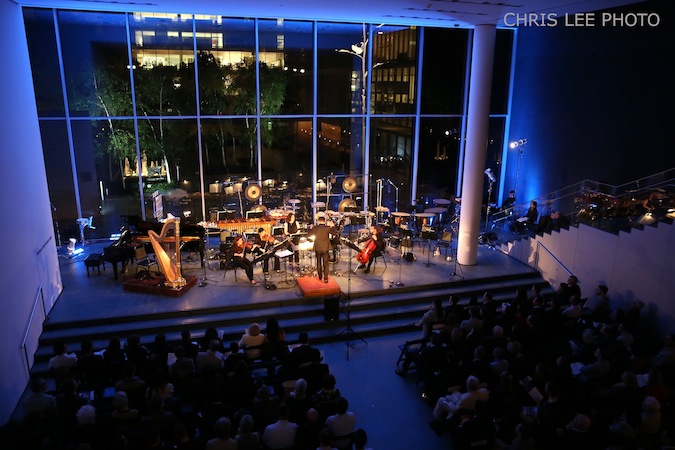Phil’s Biennial Contact! program offers many voices, fewer lenses

Matthias Pintscher led New York Philharmonic members in a Biennial Contact! program Thursday night at the Museum of Modern Art. Photo: Chris Lee
The third presentation of the New York Philharmonic’s inaugural Biennial, a Contact! series concert late Thursday night proved to be a marathon, but offered fascinating glimmers among nine U. S. premieres for reduced ensembles, even if a common aesthetic hindered the program’s musical variety.
Presented in the church-like acoustic of MoMA’s main lobby at 10 p.m., it could not have been made any more clear that this was not to be a “typical” concert experience. The nine works all debuted at the Salzburg Festival in 2013, each drawing inspiration from public sculptures that have been commissioned by the Salzburg Foundation since 2002.
Dai Fujikura’s Silence Seeking Solace was a strong opener, set to an English text by Harry Ross. Inspired by Sphaera and Frau im Fels by Stephan Balkenhol, it is a freely dissonant piece, its vocal line wandering but still insistent, with a sense of ungrounded tonality reminiscent of Britten. The soprano Jennifer Zetlan’s diction was not always clear, but her sound was consistently crisp and her phrasing was uncomplicated. She has a free, easy tone throughout her voice, with a top that could be either round or piercing. In Silence, as in the rest of the program, Matthias Pintscher’s lucid conducting kept the ensemble tight.
In one respect, Silence might have benefited from being the first piece on the program—tremolos and fast, prickling arpeggios characterized much of the string playing, while the brass blatted at irregular intervals. There is a skittering aesthetic that was strikingly evocative but lost its power as it resurfaced in many of the night’s other offerings.
For instance, Olga Neuwirth’s Piazza dei Numeri, performed with a skeleton orchestra of ten musicians, invoked a similar creeping feel as the instrumentalists scurried about under Zetlan’s playful declamation of a Fibonacci number sequence.
Michael Jarrell’s Adtende, ubi albescit veritas began with mass confusion before settling back into these familiar gestures. The bass-baritone Evan Hughes made his Philharmonic debut singing a Latin text from St. Augustine’s Confessions. His tone was rough in his lower reaches, but as he climbed higher he was able to flow more freely, and with considerable power. His spoken lines became solemn incantations, recited over moments of tender calm in the orchestra.
Bruno Mantovani’s Spirit of Alberti had a different character, opening with shimmering clamor presided over by ominous bell chimes. Mantovani employed a percussive vocabulary in this piece, making the piano a persistent stalking presence and writing harsh slaps and thrusts for the strings and brass. In stretches, Mantovani’s writing began to feel formulaic, as he would take one rhythmic pattern and explore it for about four measures before moving on to the next idea.
Some of the works after the intermission were just too clever by half. Mark Andre’s E2, a duo for cello and bass and the only piece on the program without a conductor, consisted of a ticking or dripping in one instrument paired with simple, lost lines in the other. Despite its dark sonority, there was a hint of playfulness in E2’s character as it experimented with extended technique. There was little depth of ideas to be found—the two players brushed everything but their teeth with their bows (including their bridges and the sides of their instruments) but what exactly this was supposed to tell us was unclear.
In the Absence, a piece by Nina Šenk, was the oddest offering. More stock figuration—trills in the violins and limping doodles in the winds and brass—accompanied Zetlan as she sang, chanted, and whispered her way through a bewildering text by Erwin Wurm, also the creator of the piece’s inspiration, Gurken, a set of giant, free-standing cucumbers. Its bizarre nonsense (“dynamite in the cucumber” stands out among a few memorable lines) seems to try a bit too hard to imitate the stream-of-consciousness confusion of Samuel Beckett.
Jay Schwartz displayed a sense of humor in M, a response to Markus Lüpertz’s Mozart—Eine Hommage. The piece opens with a cheeky, half-formed quotation of the opening runs of Le Nozze di Figaro’s overture. In the violins and winds these seem to be playful winks, but in the lower instruments these come across as an imposing rumble. As the quotation becomes more explicit it grows more intimidating and chaotic, until we get a sense of Mozart stomping around, Godzilla-like. Hughes’s range was stretched to its limits by a series of plodding ascending scales that pulled text from Mozart’s Requiem Mass.
Vito Žuraj’s Insideout, the closer, is a frustrated romantic dialogue between soprano and bass-baritone. The composer’s note pleads that he and the librettist Alexander Stockinger wanted to create a piece in which the “manner of emotional intensity varies drastically.” His success in that regard was mixed—more skittering dominated the piece’s soundscape, and while instrumentation and figuration changed here and there, the music had the same basic composition throughout.
The exceptional piece on the second half was the first—A trio for piano, soprano and clarinet, Johannes Maria Staud’s Caldera was played in the corner of the stage, reflecting the emphasis on perspective in its inspiration, Anthony Cragg’s Caldera. Even though Pintscher stayed on to conduct the piece, the sight of the musicians huddled around the piano lent the intimacy of a chamber performance. Staud’s use of extended technique is startlingly effective—breathy notes in the clarinet and gentle strumming on the piano’s lower strings (courtesy of the “Active page turner,” Martin Jacobs) had real expressive force, rather than just being technical curiosities. Zetlan subtly wove her way through her part’s dark lyricism.
The program will be repeated 10 p.m. Saturday, in the Agnes Gund Garden Lobby of the Museum of Modern Art. The New York Philharmonic’s biennial runs through June 7. nyphil.org/biennial.


